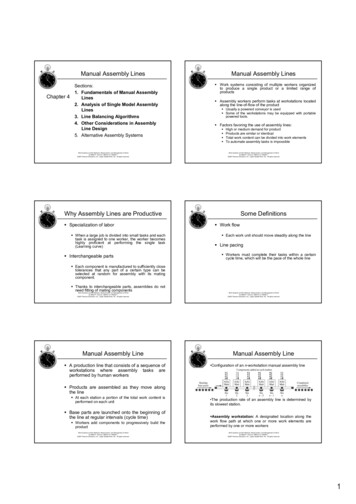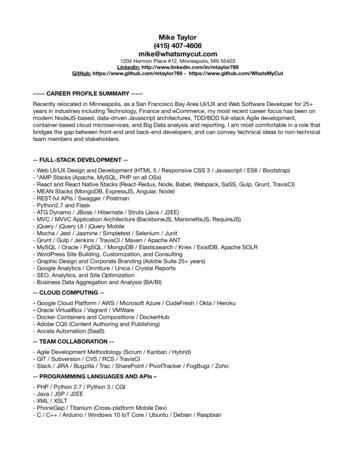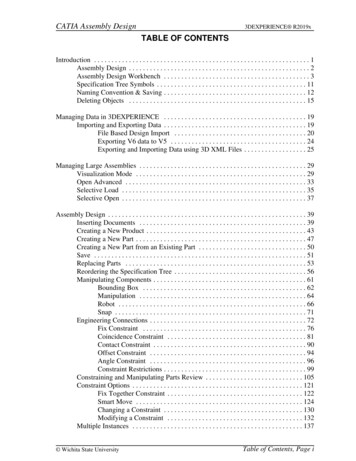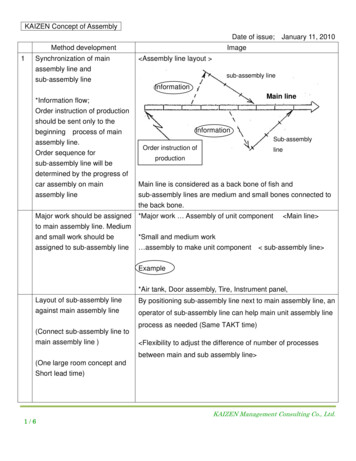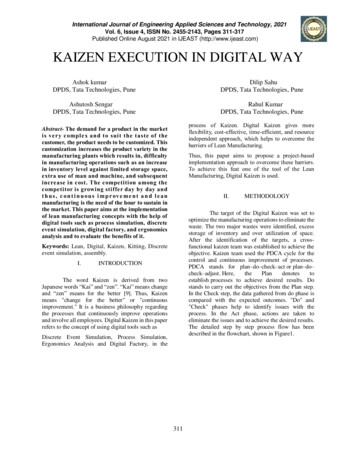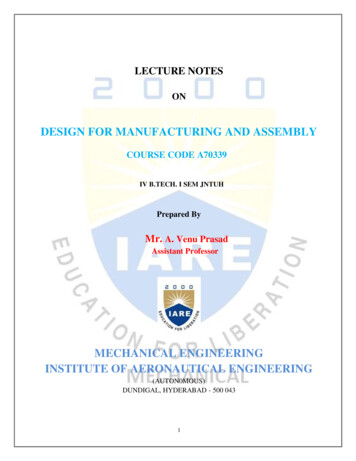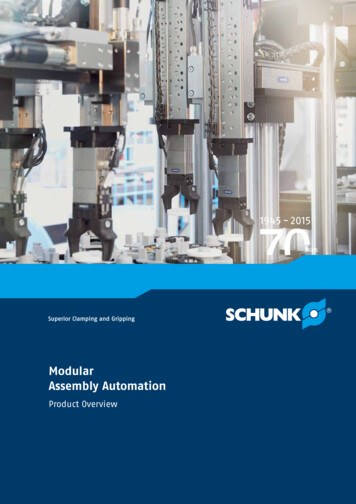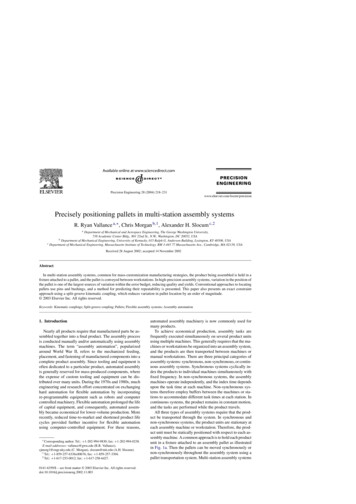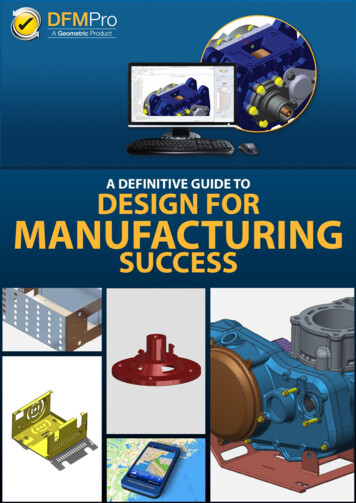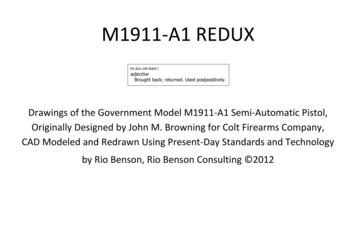
Transcription
M1911-A1 REDUXre·dux (rē-dŭks’)adjectiveBrought back; returned. Used postpositively.Drawings of the Government Model M1911-A1 Semi-Automatic Pistol,Originally Designed by John M. Browning for Colt Firearms Company,CAD Modeled and Redrawn Using Present-Day Standards and Technologyby Rio Benson, Rio Benson Consulting 2012
FROM RIO BENSON, RIO BENSON CONSULTING,ON THE PREPARATION OF THESE DOCUMENTSTo qualify my efforts in the development of this drawing package: As a Machine and Mechanical Designer, I’ve beenpreparing drawings to DOD-100/1000 and ASME/ANSI Y14 standards, for a living, for more than a half century. I am ashooter and a firearms enthusiast with sporting experience since my mid-teens and significant military firearmsexperience from my late teens to my late-twenties. I am also an avid fan of John M. Browning and the “original” M1911.Historically, when the drawings for John M. Browning’s Colt M1911 were first created, there was little in the way of‘consensus’ standards to guide the designers and manufacturers of the day in either drawing format or in DODdocumentation of materials and finishes. For the most part, these were added, hit or miss, in later drawing revisions.Furthermore, due to the original design’s flawless practicality and it’s amazing longevity, the government’s involvement,and the fact that in the ensuing 100-plus years of production the M1911 design has been officially fabricated by severaldifferent manufacturers, the drawings have gone through many, many revisions and redraws in order to accommodateall these various interests. These ‘mandated by committee’ redraws and revisions were not always made by the mostcompetent of designers, and strict document control was virtually non-existent at the time. All of this has led to anexceedingly sad state of credibility, legibility, and even the availability of legitimate M1911 drawings today.Granted, the M1911 is still being produced by a multitude of manufacturers, but obviously not to the original drawings.The current manufacturers have their own documentation, including their own modifications and productionimprovements. Because of their competitiveness, there is little chance any of these current manufacturers will publishor furnish any part of their documentation, since they might be giving away some of their trade secrets. Of course, wemust assume that none of these manufacturers have ever heard of “reverse engineering” [LOL].With that being said, I have noticed numerous requests for M1911 drawings over the years, and now having the time,the knowledge, and the means, I decided to model the M1911 in 3D, using SolidWorks 2012, and then create updateddrawings from those models. My source for the original[?] drawings came, free of charge, from the internet. As adrawing set for the M1911 these were better than nothing, but they were full of misinterpretations, errors, omissions,in addition to being very difficult to read. Unfortunately, that was all that was available.Due to the poor legibility of the reduced drawing sizes, original drafting quality, and reproducibility of the sourcedocuments, and also of the collective questionable veracity of revision status, a number of assumptions and eveninterpolations had to be made in the creation of the subject documentation package. While every attempt was maderegarding the maintenance of technical correctness and completeness, I (Rio Benson), or Rio Benson Consulting, cannotwarrant or guarantee the package’s accuracy or suitability for manufacture, and recommend its use be limited to onlythat of a source of interesting and historical information. This package is furnished free of charge, and the user mustassume any and all liability in any connection with its use. The laws regarding intellectual property apply here. Thisdocumentation may be published and distributed freely as a complete package, without charge, provided nothing isaltered in any way. Furthermore, this writing is an integral part of the package and must accompany it in any of itspublished forms. By the way, this package prints best on a tabloid (11 x 17 inch) printer, color or no. Only two sizes ofdrawing format were used, B (11 x 17) and D (22 x 34). The advantage of the D size is less format per drawing area. TheD size printed on a tabloid sheet results in a half-size reproduction (half-size is not half a sheet; do your math) that is stillquite legible for all but the legally blind.
All of the SolidWorks 2012 models and drawings created for this package are available from me, at riobenson@clear.net,for a small donation to help cover my expenses in materials, equipment, and time. While I will gladly assist anyonewishing it, technically, I am not in the habit of doing anyone’s work for them without some form of compensation.The approach to the updated modeling and redrawing contained in this package was as follows:1. Wherever possible, ‘turn-of-the-century’ machine shop methodology and technology was used in determiningthe design intent of the original documentation.2. Otherwise, no attempt was made to arbitrarily change any dimensions or tolerances, however costly they wouldbe to reproduce. There were, however, a few instances where the “original” dimensions were geometricallyimpractical to fabricate or were incorrect, thus dictating a change. Furthermore, the application of currentdrafting standards required some additional minor changes. Overall, and as an added benefit, the changesmade should make the drawings more legible, logical, and easier to read.3. Manufacturing technology in materials, heat treatment, and finishes have changed considerably in the pastseveral years, thereby making virtually all of the “original” drawing notes obsolete. In fact most of thestandards and specifications originally referred to have been obsoleted or superseded. As a result the remainingdrawing notes, referring primarily to materials, heat treatment, and finish, have been standardized and updatedto what is currently available and more practical from a manufacturing standpoint, in this package.4. Some of the newer methods in drafting technology, such as Geometric Dimensioning and Tolerancing, andparticularly that of True-Position Dimensioning, have been purposefully avoided in this effort. These were notavailable for the original design, nor were they necessary. The use of these practices becomes economicallyfeasible only in high volume production applications where the technical expertise is available, and the purchaseand deployment of expensive Coordinate Measuring Machines (CMM) and costly templates and gages can bejustified. Seldom, if ever, are the tried and true bilateral tolerancing methods of the past insufficient tomanufacture excellent parts. Case-in-point, the decades old M1911-A1 design, itself, using no GeometricTolerancing, has had a success and longevity that is unmatched throughout all industry. Go figure! [BG]5. No attempt was made to make these drawings DOD compliant. The driving intent here was to illustratedimensional accuracy and functionality of the overall design. Markings, references to inspection of surfacehardness, and other superfluous military requirements were omitted. The optional alternative designs weregenerally used since they represent improved or simplified fabrication methods.In the creation of this documentation package, a number of issues became quite obvious and apparent: To begin with, itis doubtful the multitude of the very complex and intricate features found on the many parts of the M1911-A1 werepresent, or even necessary, in John M. Browning’s original design before Colt and the government got hold of it. Thissort of complexity was just not his style, and moreover, is probably the result of too many cooks stirring the soup. Theresult is a firearm that may be too expensive to fabricate for today’s consumer market, without radical simplification.Hence, resulting “copies” of the M1911-A1 are now being produced by many very expert manufacturers, that whendisassembled and measured would bear some differences to what is described in this package. For my money and in myopinion, the modern “copies” are often better weapons than the so-called “original”, and are probably closer to whatJohn Browning originally intended. However, inadvertent tighter tolerances can and do defeat field use practicality.Rio Benson, Rio Benson Consulting 2012www.Rio-Benson.com
87654321REVISION HISTORYNOTES:ZONE1.PISTOL IS SHOWN IN CONDITION ONE, COCKED, LOCKED AND LOADED.2.0625 .0005 MATCH DRILL AT ASSY THRU EXISTING HOLE IN ITEM 1,RECEIVER, AND LONG LEG OF ITEM 22, EJECTOR, PRIOR TO PRESS-FITITEM 23, EJECTOR PIN.TAB LOCKS INTO CIRCULARSLOT IN ITEM 1, 511322638SECTION C-CSCALE 3 : 12223SEE NOTE 45NOTICE GRASP ONCARTRIDGE CASE81C29327436SECTION A-A54B47A48B9SECTION B-BBOM 74346BOM TRIGGER ASSEMBLY16008602SPRING, SEAR [MFA]15503841HOUSING, MAINSPRING15013213PIN, RETAINER, MAINSPRING HOUSING15013208MAINSPRING15013209CAP, MAINSPRING1BC10091602PIN, MAINSPRING CAP15013212PIN, MAINSPRING , SEAR15503839HAMMER16008600STRUT, HAMMER15013207PIN, HAMMER STRUT15013206PIN, HAMMER16501828SAFETY, GRIP15503840LOCK, SAFETY16008609CATCH, MAGAZINE15013217SPRING, MAGAZINE CATCH15013218LOCK, MAGAZINE CATCH16019204EJECTOR15013203PIN, 90231BC100905011NONE1BC100916034DESCRIPTIONSIGHT, FRONTSIGHT, REARSPRING, FIRING PINPIN, FIRINGEXTRACTORSTOP, FIRING PINBARRELBUSHING, BARRELLINK, BARRELPIN, BARREL LINKPLUG, RECOIL SPRINGSPRING, RECOILGUIDE, RECOIL SPRINGSTOP, SLIDETUBE, PLUNGERPLUNGER, SLIDE STOPSPRING, PLUNGERPLUNGER, SAFETY LOCKBUSHING, STOCK SCREWSTOCK, RH, PLASTICSCREW, STOCKSTOCK, LH, PLASTICCARTRIDGE - REFERENCE ONLYMAGAZINE ASSY40413942SECTION D-DSCALE 3 : 1rio Benson ConsultingMODELEDDRAWNBYDATER Benson 09/25/20101467 Georgetowne Drive, Gastonia, NC 28054 riobenson@clear.netR Benson 09/29/2010 TITLE3D MODELED AND DRAWN VERSIONOF THE M1911-A1 .45 ACP PISTOL―MATERIAL1st MADE FOR:N/ASIZEHEAT TREATN/AM1911-A1 REDUXDWG NO.REVD M1911-A1 REDUX ASSEMBLYFINISHN/A3SCALE: 3:2WEIGHT: 2.93 LBTHE INFORMATION CONTAINED IN THIS DRAWING IS THE SOLE AND INTELLECTUAL PROPERTY OF Rio Benson Consulting.ANY REPRODUCTION IN PART OR AS A WHOLE WITHOUT THE WRITTEN PERMISSION OF Rio Benson Consulting IS PROHIBITED.SHEET 1 of 11A
87654231REVISION HISTORYREVDESCRIPTIONDATEAPPRVDDD.47CC .000.107- .004.0895 .0000- .0030.025 MAX.0645 .0000- .0030 .000.115- .01060 R SPHER (.045)R.030BB.13DATE PLOTTED: 5/25/2012 .000.222- .010AAPROPRIETARY AND CONFIDENTIAL:THE INFORMATION CONTAINED IN THIS DRAWING ISTHE SOLE PROPERTY OF RIO BENSON CONSULTING.ANY REVIEW, RETRANSMISSION, DISSEMINATION,COPYING OR OTHER USE OF, OR THE TAKING OFANY ACTION IN RELIANCE UPON THIS INFORMATIONBY PERSONS OR ENTITIES OTHER THAN THETHE INTENDED RECIPIENT, IS PROHIBITED.QTY REQD PER NEXT ASSY 1DO NOT SCALE DRAWING8765RIO BENSONCONSULTINGUNLESS OTHERWISE SPECIFIED [UOS]:DIMENSIONS ARE IN INCHES.TOLERANCES PER DECIMAL PLACE:.X .05, .XX .02, .XXX .005, .XXXX .0005ANGLES .5 , MACHINED FINISH 63-125 µIN.REMOVE ALL BURRS AND SHARP EDGES .02 MAXINTERPRET DRAWING IAW ANSI Y14.5M -199441467 Georgetowne DriveGastonia, North Carolina 28054TITLE:PLUNGER, SLIDE STOPriobenson@clear.netMATERIAL: STL 1117THIRD ANGLEASTM A108HEAT TREAT: CASE DP .002-.005RH 15-N 78-82FINISH: MIL-STD-171,PARA 5.3.1.2DRAWN BY:PROJ: M1911-A1 REDUXNAMEDATER Benson08/29/2010DWG/PART NO.BSCALE: 8:1APPROVED BY:3SIZE2REV5013193WEIGHT: 0.00 LBSSHEET 1 OF 11
87654231REVISION HISTORYREVDESCRIPTIONDATEAPPRVDDDMODEL SHOWN COMPRESSED FOR ASSEMBLYNOTES:CDIAMETER OF WIRE . .0181.MANUFACTURE IAW TYPE 1, GRADE A,OF SAE AS 13572.DIAMETER OF COIL (OD) . .104 .0032.STRESS RELIEVE AT 450 F FOR 20MINUTES AFTER FORMING.FREE LENGTH .(.593)CACTIVE COILS . 12.5TOTAL COILS . 14.5DIRECTION OF HELIX . CCWLOAD AT COMPRESSED LENGTH OF . .400 2.50.50 LBSPRING RATE . (.160 LB/INCH)BBSOLID LENGTH . .279 MAXDATE PLOTTED: 5/21/2012TYPE OF ENDS . SQUARED & GROUNDHOLE DIA INTO WHICH SPRING FITS FREELY . .109 MINROD DIA OVER WHICH SPRING SLIDES FREELY . ----- MAXAAPROPRIETARY AND CONFIDENTIAL:THE INFORMATION CONTAINED IN THIS DRAWING ISTHE SOLE PROPERTY OF RIO BENSON CONSULTING.ANY REVIEW, RETRANSMISSION, DISSEMINATION,COPYING OR OTHER USE OF, OR THE TAKING OFANY ACTION IN RELIANCE UPON THIS INFORMATIONBY PERSONS OR ENTITIES OTHER THAN THETHE INTENDED RECIPIENT, IS PROHIBITED.QTY REQD PER NEXT ASSY DO NOT SCALE DRAWING8765RIO BENSONCONSULTINGUNLESS OTHERWISE SPECIFIED [UOS]:DIMENSIONS ARE IN INCHES.TOLERANCES PER DECIMAL PLACE:.X .05, .XX .02, .XXX .005, .XXXX .0005ANGLES .5 , MACHINED FINISH 63-125 µIN.REMOVE ALL BURRS AND SHARP EDGES .02 MAXINTERPRET DRAWING IAW ANSI Y14.5M -199441467 Georgetowne DriveGastonia, North Carolina 28054TITLE:SPRING, PLUNGERriobenson@clear.netMATERIAL: STEEL MUSIC WIRETHIRD ANGLEASTM A228HEAT TREAT: SEE NOTE 2DRAWN BY:FINISH:PROJ: M1911-A1 REDUXNAMEDATER Benson08/29/2010DWG/PART NO.BSCALE: 8:1APPR
Originally Designed by John M. Browning for Colt Firearms Company, CAD Modeled and Redrawn Using Present-Day Standards and Technology by Rio Benson, Rio Benson Consulting 2012 re·dux (rē-dŭks’) adjective Brought back; returned. Used postpositively. FROM RIO BENSON, RIO BENSON CONSULTING, ON THE PREPARATION OF THESE DOCUMENTS To qualify my efforts in the
